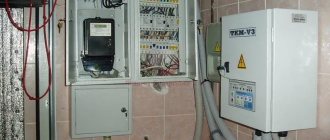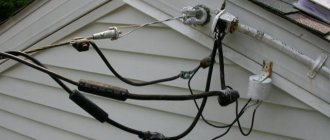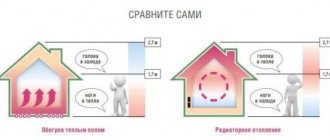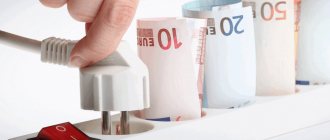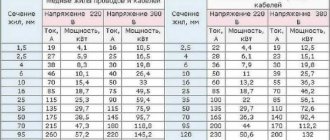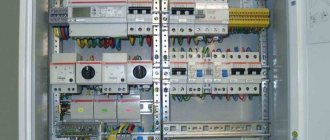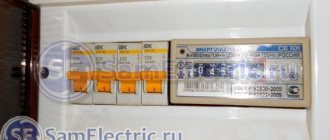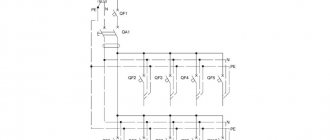Author of the article
Alexander Georgievich Kondratiev
An electrical engineer by training, he worked as an electronics engineer, chief engineer at a food company, and general director of a construction organization.
Before you begin installing an electric meter in a private home, you need to carefully study the rules. They differ significantly from the conditions for installing an electricity meter in an apartment. Typically, such metering devices are installed outdoors. This is necessary so that the energy sales inspector can easily check the status of the meter and monitor the readings.
Starting from July 1, 2022, new rules for installing metering devices will apply. Resolution of the Government of the Russian Federation dated April 18, 2020 N 554 “On introducing amendments to certain acts of the Government of the Russian Federation on improving the organization of electrical energy metering” was approved. Now electric networks install meters at their own expense, free of charge for the consumer.
According to the new law, all property will be equipped not with ordinary meters, but with “smart” ones - intelligent means of electricity metering (ISEM). For now, these are only recommendations, and from January 1, 2022, only smart devices will be allowed to be installed.
Types of electricity meters
The legislation provides for equipping all residential and non-residential buildings with electricity meters; responsibility for this lies with the owner of the premises.
For the convenience of the population, various device options are offered:
- Mechanical or induction. Quite widespread, as they were installed everywhere over a long period of time. They are distinguished by their reliability and durability, but at the moment such IPUs are gradually losing popularity due to their low accuracy class. The principle of operation is the formation of a magnetic field between two coils, which causes the counting mechanism to rotate.
- Electronic. Modern devices guarantee extreme accuracy, since measuring current and voltage does not require the presence of a magnetic field, which eliminates losses. Such an electric meter has many advantages, but in case of failures and fluctuations it can fail.
There are types of IPU depending on the type of nutrition:
- Single-phase. The most common option, suitable for residential and small domestic premises. Mounted on two-wire networks with a standard voltage of 220 volts.
- Three-phase. They are used for technical and industrial facilities, as well as private houses and apartments equipped with powerful electrical appliances. Suitable for three- and four-wire networks with a voltage of 380V.
In the vast majority of cases, private houses and city apartments are equipped with single-phase electricity meters; the use of three-phase metering devices is allowed with a large potential load and a housing area of 100 m² or more
To save money, the following types of electricity meters have been developed:
- Single tariff. Standard option, which takes into account consumption around the clock at a single price.
- Multi-tariff. They are divided into zones according to the time of day: two-tariff and three-tariff. When using electricity at night, significant savings are achieved, but during peak hours the tariff is maximum.
Read more about which electricity meter is best to install in an apartment.
You should know! Service organizations cannot force the owner of the premises to install an IPU, but in this case the payment is calculated according to the standard with an increasing coefficient, which leads to the accrual of significant amounts.
What kind of meters are installed?
There are various models available for electricity metering. The most common devices were induction meters. However, these devices are outdated and are gradually being phased out.
There are electronic electricity meters with an accuracy class of 0.5. They can operate in both single-tariff and multi-tariff modes.
In the private sector, where electricity is constantly consumed throughout the day, the use of a two-tariff meter is justified. Especially if the heating is provided by electricity, and at night the area near the entrance needs to be illuminated.
And when using a washing machine with a delayed start, you can get even greater savings. Therefore, the installation of a two-tariff meter is justified.
From July 1, 2022, the installation of smart meters is recommended. They provide electricity metering and data transmission to the dispatcher automatically.
At the same time, the dispatcher remotely monitors electricity consumption in real time. In addition, smart meters allow you to monitor the status of the network and inform the dispatcher about an illegal connection or attempt to steal electricity.
In turn, through such devices the dispatcher can turn off or limit the supply of electricity and change the daily tariff. These are promising metering devices.
They are now recommended for use. And from January 1, 2022, EMIS devices should be used everywhere.
Thus, now power engineers have the right to choose the type of meter themselves. So far, the law only recommends the use of “smart” devices. Mandatory installation of automated control systems will be carried out only from January 1, 2022.
The Resolution stipulates that the purchase of equipment and installation must be carried out by the organization supplying electricity at its own expense.
If you install an “ordinary” meter now, the energy supply company is obliged to register it. Replacement will be made at the end of its service life.
In some regions, scammers take advantage of the fact that residents do not understand the laws and sell them equipment.
Installation Rules
Installation and connection of the electricity meter is carried out in accordance with the recommendations prescribed in the PUE:
- The room must be dry. If you plan to place it on a pole or the facade of a building, then the device must be marked that it is suitable for outdoor installation at temperatures down to –40 degrees.
- Height from the floor - from 80 to 170 cm. Placement below 0.8 m is allowed, but subject to a 40 cm indentation.
- The mechanism and additional elements are placed in a shield or special box. All parts must be well recorded.
- When connecting an electric meter, you must exclude any illegal connections that could be made to the installation site of the device.
- It is recommended to leave a supply of live wires to ensure convenience during replacement or other actions and to eliminate the need for extension.
- Electrical wiring should not be twisted or soldered; in case of increased fragility of the elements, a complete replacement of the supply section is required.
- The IPU is placed strictly horizontally; distortions can lead to malfunction.
- All wires are marked or connected according to the accepted color identification.
The installation height of the meter indoors and the installation level of the cabinet with the meter outdoors are absolutely the same, the difference lies in the presence or absence of a protective box
Existing requirements must be observed; deviations from the rules that affect operation and safety will result in the impossibility of putting the device into operation.
What legislative acts can be referred to when refusing to transfer a meter?
Rice. 3 What do the laws indicate?
If you refuse to install an electric meter on the street in 2022, you can refer to the following legislative acts:
- Clause 1.5.27 PUE – installation of electrical equipment, selection of a location with optimal conditions for it;
- Clause 1.5.29 PUE - permissible installation height and rules for storing meters, for example, in special cabinets;
- Art. 210 of the Civil Code of the Russian Federation - responsibility for the safety and uninterrupted operation of equipment.
Government Decree No. 354 of 2011 also confirms the listed standards and does not indicate other parameters.
Installation location
For the placement of electrical power supply units, there are standards that regulate the procedure.
Multi-storey building
Such buildings are built in compliance with many technical rules, which guarantees a convenient and safe supply of electricity. A special panel room on the landing is allocated for metering devices.
In modern apartment buildings, IPUs are most often installed directly in the apartment. This not only allows the owner to control the readings, but also ensures the safety of the mechanism, for which the homeowner is responsible.
Private or country house
The most common option for placing an electric meter is a pole from which wires for connection are drawn, which limits the possibility of illegal connection. But since the place is located on the street, ensuring the safety of the device becomes difficult.
It is possible to install the device in a protective box on a special pipe stand or pole in a fenced area. The installation site should not be cluttered or difficult to access.
The law does not prohibit installing an electric power supply directly in the premises, which is especially important for a seasonally visited summer house or a private house that was previously equipped with an electric meter inside. But approval of such work may require going to court, which does not always side with the owner.
Garage
If there is energy-intensive equipment at the facility, a three-phase meter is installed. If the room is used only for storing a vehicle or some things, then single-phase is sufficient.
The placement order depends on the specific situation. Installation of the IPU on the street is allowed: a nearby pole or a special structure is suitable for this. Internal fixation is carried out according to standard connection requirements.
On a note! It is important to ensure unhindered access to the electric energy meter for representatives of the service organization; the protective box should be easy to open for inspection.
What to do?
Let's think like this. If you, as the owner of the house, do not prevent inspectors from the energy supply organization from taking meter readings, then what is the point of installing it on the street. Of course, there will be disputes and connection problems. But then demand that the balance sheet be differentiated, that is, let the organization itself be responsible for the electricity meter. After all, the device you purchased and installed inside your home will be considered your property, for which you will be responsible. But if the device is installed on the street, and even more so on a pole, then let representatives of the energy supply organization be responsible for this. It is imperative that such a clause be included in the contract when moving, installing or replacing an electric meter.
Installation of an electricity meter in a private house
To connect the meter correctly, you must follow the instructions.
Work order
Placing an IPU in a home requires certain skills. It is important to accurately calculate the planned power, which depends on the availability of electrical equipment. Based on this value, the type of device is determined: single- or three-phase.
Stages of approval and installation:
- An application for the need to connect a building to the power grid is submitted to the appropriate organization. The required power is indicated, supported by calculations, and the model and type of electric meter must be included. The authorized person issues a standard contract and provides the technical conditions necessary for connection. Coordination of individual details may be necessary.
- An individual project is drawn up. For these purposes, a specialist from a sales company or a certified company is involved.
- After clarifying all the nuances and obtaining permission, you can install the box and place an individual meter.
- To seal the electricity meter, if installation work is carried out independently or by a third party, you need to call an energy network employee. He will check the connection and, if everything is correct, will seal it and draw up a corresponding report. From this moment the electric meter is considered to be put into operation.
In the absence of experience and skills, it is recommended to involve specialists.
Taking the device outside
At the moment, due to the requirements of Energosbyt to install the meter not inside the premises, but outside, some disagreements are arising. Various location options are available: façade, pillar or specially erected structure.
Representatives of the company refer to Decree of the Government of the Russian Federation of May 4, 2012 No. 442. Indeed, the law states that IPUs must be installed along the border of the balance sheet ownership of the company’s energy networks and the site of the owner of the facility. This territory means the facade of a building or a boundary pillar, so many owners of private houses are required to take the device outside.
But if the owner does not want to change the location of the electricity meter, the owner can appeal to the PEU, which states that the mechanism must be located in a dry room with a temperature not lower than 0 °C. In addition, the consumer is directly responsible for the safety of the IPU, according to the Civil Code of the Russian Federation and RF PP No. 354. Thus, if the owner provides convenient, unobstructed access to the electric meter, there is no need to reinstall it.
You should know! Since the existing requirements contradict each other, if it is impossible to reach a compromise, the owner must contact the regulatory authority, prosecutor's office or court.
Who should install an electric meter and at whose expense
Before the law was issued, the responsibility for purchasing and installing metering devices was assigned to the owner. From July 1, 2022, there have been significant changes in legislation.
Now the purchase, installation of an electricity meter in a private house or apartment, and its commissioning are entrusted to the organization supplying electricity. In the private sector, these are electrical networks. This issue has been removed from consumers: the owner does not have to buy an electric meter, pay for installation and verification. For residents, this is conditionally free: the electric network will not present a separate bill for the device, but these costs are included in the tariff by default.
The owner must fulfill the following requirements:
- In private houses with three-phase power supply there must be a grounding loop. Parameters and permission to operate electrical equipment are issued by the electrical measuring laboratory;
- Provide access to power engineers to install the meter. At the same time, the owner must take into account that to check the functionality and take readings, free access to the electric meter is provided at any time. This involves installing an electric meter in a private house on the street. That is, it is mounted on the facade of a house, a fence or a free-standing support.
Do-it-yourself single-phase meter installation
To carry out installation yourself, it is recommended to proceed sequentially.
What will you need?
To work you need to prepare:
- Automatic machines. To shut down in case of an emergency.
- DF or RCD that breaks the circuit during a leak or short circuit.
- Boxing or special cabinet. The option is selected depending on the installation location.
- DIN rails for fixing equipment.
- Adapters, busbars and additional elements for connecting various parts.
- Voltage indicators and limiters.
- Standard set of tools.
- Single-phase electricity meter. The model is selected depending on the situation; devices from the Energomera brand are popular
Carrying out installation work
Installation of equipment and components:
- A box or cabinet is placed in a given place, and parts for hanging are fixed inside. The reliability and rigidity of the structure is checked. It is taken into account that height and accessibility must be respected.
- A two-pole circuit breaker is installed to quickly de-energize the home network. It is installed in front of the IPU, which is stated in the PEU.
- A new metering device is hung on the DIN rail, the evenness and reliability of placement is checked.
- If desired, an RCD is installed. You can skip this step and immediately install single-pole circuit breakers.
- The zero bus is fixed at the bottom of the box, and wires are prepared to create jumpers.
How to connect an electric meter
The equipment must be connected according to the following diagram:
- The supply wire is disconnected and sequentially inserted into the connectors of the two-pole circuit breaker (top). For convenience, you need to use color identification or mark the phase and zero.
- The meter is connected. The order of terminals on the device can be found in the passport.
- A jumper is stretched from the phase contact of the input circuit breaker to the IPU; the connection point on the mechanism is most often located at the very beginning.
- The neutral wire is fixed. It should go from the two-pole machine to the meter terminal (for most products No. 3), but not come into contact with the previous one.
- The phase with the IPU is allocated to single-pole circuit breakers or RCDs (can be located in the system before or after the machines, the second option is more preferable). The zero is fixed to the bus located below.
- (if available) and through the adapter part is immediately sent to the connected equipment, bypassing additional components.
Single-phase meter connection diagram
At this stage, the electricity meter is considered connected. To connect the house, a phase is supplied from the circuit breakers to the distribution box, and a zero from the zero bus.
Attention! All work is carried out with the network de-energized. The wires acting as a jumper are stripped and fixed to the contacts so as to eliminate the protrusion of the bare part. The terminal screws are pulled several times.
How to arrange a closet
To protect the electrical appliance from exposure to atmospheric moisture and low temperatures, it is necessary to prepare a special box. The box is made and assembled in advance, before installing the device. The cabinet is made of metal, taking into account the following nuances:
- protection against burglary is provided - the box is securely fastened and a locking device is installed;
- the box must be sealed so that moisture does not penetrate inside;
- To protect against low temperatures, the box is insulated. In the absence of proper thermal insulation, the device will calculate with an error, not in favor of the consumer.
A metal pipe is used to supply wires. One circuit breaker is installed directly in the cabinet; additional circuit breakers for disconnecting individual sections of the network are installed in the home distribution panel.
More details about the box for the electricity meter in the article: Box for the electricity meter
Features of installing an electricity meter in an apartment
To save money, it is recommended to install special devices that record consumption by time zones.
Connection diagram for two-tariff IPU
The procedure for connecting such a mechanism is not very different from a single-phase and three-phase device. The only difference is the larger number of contacts, which requires the use of suitable machines.
Sequencing:
- An input element is built into the system, from which jumpers are connected to the meter.
- RCDs or single-pole circuit breakers are installed. For a three-phase device, a three-phase load circuit breaker is installed in the network.
- The phase contacts are connected to each other, the zero is taken to the bus.
- Setting up. To do this, you need to call a specialist from the energy sales company.
If the owner makes the connection himself, it is important to follow the diagram presented in the technical documentation.
A two-tariff electric meter is connected according to the same scheme as a single-tariff one, but the device requires additional configuration after installation
How to register a new counter
Commissioning of the device is mandatory, otherwise the readings will not be taken into account.
Registration procedure in 2022:
- An application is submitted to the utility service provider (MC, HOA, Energosbyt). The document contains all the IPU information, personal data and address. A copy of the product passport is attached.
- At the appointed time, an employee will come and check the functionality of the mechanism and the correct installation. Adjustments are made if necessary.
- If there are no comments, then sealing is carried out and a corresponding report is drawn up.
- The supporting document is submitted independently or through a specialist to the service company.
After completing all procedures, the electric meter is considered registered and put into operation.
Documentation
You can try to negotiate the location of the meter in advance, and if you guarantee employee access to the house to inspect and check the device, the problem will be solved. If not, then it still won’t work without a counter.
To perform the installation work, an average electrical qualification is sufficient; you can invite an electrical engineer yourself if the services of the company’s specialists are too expensive.
If the installation will still be on the street, it is necessary to require a clear division of responsibility, which will be reflected in the contract.

